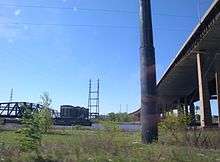Point-No-Point Bridge
| Point-No-Point Bridge | |
|---|---|
 | |
| Coordinates | 40°44′29″N 74°07′17″W / 40.74148°N 74.12136°WCoordinates: 40°44′29″N 74°07′17″W / 40.74148°N 74.12136°W |
| Carries | Passaic and Harsimus Line |
| Crosses | Passaic River |
| Locale |
Newark and Kearny New Jersey |
| Owner | Conrail |
| Characteristics | |
| Design | Swing bridge |
| Clearance below | 21 feet (6.4 m)[1] |
 Point-No-Point Bridge Location in the Port of New York and New Jersey | |
Point-No-Point Bridge is a railroad bridge crossing the Passaic River between Newark and Kearny, New Jersey in the New Jersey Meadowlands.The swing bridge is the fourth from the river's mouth at Newark Bay and is 2.6 miles (4.2 km) upstream from it.[1]A camelback through truss bridge, it is owned by Conrail as part of its North Jersey Shared Assets and carries the Passaic and Harsimus Line used by CSX Transportation and Norfolk Southern.[2]
A crossing of the Passaic at Point No Point was originally built by the Pennsylvania Railroad (PRR) in the early 1890s[3] to bypass its mainline and thus shorten the distance to its railyard at Harsimus Cove.[4] At the time the railroad crossed the Passaic at the Centre Street Bridge (no longer in existence) near its Newark station, at the site of today's New Jersey Performing Arts Center. The new Pennsylvania Cut-off diverged from the line (now today's Northeast Corridor) at Waverly Yard, crossed the Newark Ironbound and the Passaic to the Kearny Meadows and then crossed the Hackensack River on the Harsimus Branch Lift Bridge. It rejoined the main line at the Bergen Hill Cut, but diverged again using the Harsimus Stem Embankment to reach its freight yards on the Hudson River waterfront north of its passenger terminal at Exchange Place. The PRR also used the Lehigh Valley Railroad Bridge to reach its car float operations at Greenville Yard on the Upper New York Bay.[3]
The Point-No-Point Bridge's creosote-covered piers caught fire in 2000.[5]
The lower 17 miles (27 km) of the 90-mile (140 km) long Passaic River below the Dundee Dam is tidally influenced and navigable Commercial maritime traffic upstream of the Point-No-Point Bridge is constricted by the width between its piers when the moveable span is open.[1] Rules regulating the drawbridge operations determined by the US Coast Guard require a 4-hour notice for it to be swung open.[6]

See also
- List of bridges, tunnels, and cuts in Hudson County, New Jersey
- Timeline of Jersey City area railroads
- List of crossings of the Lower Passaic River
- Marion Junction
- Oak Island Yard
References
- 1 2 3 "Lower Passaic River Restoration Project Commercial Navigation Analysis (2nd Revision)" (PDF). United States Army Corps of Engineers. July 2, 2010. Retrieved 2012-08-05.
- ↑ http://www.northjersey.com/news/oil-train-bridges-targeted-in-study-group-says-span-over-passaic-river-decaying-1.1454004
- 1 2 "Two Small roads being Built in New-Jersey Important Extensions of the Pennsylvania Railroad to Relieve Overtaxed Jersey City Terminals", The New York Times, July 1, 1891, retrieved 2012-08-08
- ↑ "Work on the Pennsylvania Cut-off", The New York Times, May 12, 1900, retrieved 2012-08-07
- ↑ http://www.nytimes.com/2000/07/15/nyregion/bridge-on-passaic-river-burns-filling-sky-with-thick-smoke.html The New York Times, 2000
- ↑ "33 CFR 117.739 - Passaic River.". Code of Federal Regulations. Coast Guard, Department of Homeland Security. updated to July 1, 2010. Retrieved 2012-08-07.
The draw of CONRAIL's Point-No-Point Railroad Bridge, mile 2.6, at Newark, shall open on signal if at least four hours notice is given to the CONRAIL Movement Desk. After the signal to open is given, the opening may be delayed no more than ten minutes
Check date values in:|date=(help)